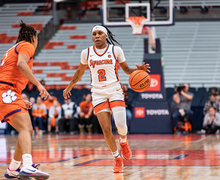The prevalent dangers of sexualizing females in the film industry
Yiwei He | Illustration Editor
A study conducted by Plan International found that women were four times more likely to have scenes containing nudity than men.
There’s still one Orange to root for — The Daily Orange! Donate today and help us win College Media Madness.
The femme fatale, the crazy ex-girlfriend, the ice queen — female characters are no stranger to stereotypes. Historically, women are portrayed as traditionally feminine archetypes and afforded specific, niche narratives. Though Hollywood has progressed significantly in female representation, these stereotypical character tropes continue to dominate the big screen, perpetuating unattainable beauty standards and marring women’s self-worth.
In their “The Future is Female” study, the Annenberg School for Communication and Journalism at the University of Southern California examined the 900 top grossing movies of the past decade, specifically women ages 6-20 and the extent to which they were typecast. Findings include 35.8% of female characters depicted doing chores — 93.2% of those being “stereotypically feminine” — 12.2% of women engaging in STEM-related activities and 31.7% of females in an academic setting.
Professor Stacy L. Smith, one of the study’s researchers, described this discovery in an interview with the Annenberg School.
“The entertainment industry continues to tell stories that bear little resemblance to the reality of today’s girls and young women,” she said. “Where are their intellectual pursuits? Their interest in STEM? Their desire for justice and equality? Those passions are not being shown with frequency in popular movies.”
The study’s primary focus explored the hypersexualization of female characters. According to the study, teenage girls were nearly four times more likely to be costumed in promiscuous clothing than teenage boys. They were also about twice as likely to be depicted in partial nudity over male counterparts, same as having thin figures.
These findings are not unique to the Annenberg study, nor to the teenage demographic. Another study conducted by Plan International compared female characters in high-level leadership roles to male characters and their on-screen portrayals. The study found that the female leaders or bosses were four times more likely to have scenes containing nudity than their male counterparts. Nearly one third of powerful female characters were costumed in revealing clothing, while that percent was only 7% for male characters. The study said that “playing a boss does not stop women being treated as eye candy in films.”

Maya Goosman | Digital Design Director
As the saying goes, sex sells. Movies that objectify and sexualize women consistently are higher grossing over those that do not.
Adriana Mucedola, a doctoral candidate in the Newhouse School of Public Communications, said that this phenomenon and the way it dominates female media is present across all spheres, not just film.
“Historically sex has ‘sold’ because it’s a technique to garner attention for consumers. This is a common problem not in movies, but media in general: the objectification of women. … Women are expected to be these docile creatures who have the sole purpose to please men,” Mucedola said. “Sex sells for that very reason, it is a very easy marketing ploy.”
Mucedola, whose research examines female portrayals in advertising and its impact on females, said that these hypersexualized depictions can have grave implications on those consuming them, particularly self-objectification. She also related this back to cinematic portrayals.
“Women will internalize people’s objectification of them and then project that onto themselves. … Most women don’t look like the women we see on the big screen. It does take a big mental toll on people to constantly engage in social comparison,” Mucedola said. “You might think, ‘I don’t look like that, what’s wrong with me?’ … ‘Her worth comes from her looks and if I don’t look like that, then my worth must not mean anything.’”
Mucedola added that when the media-driven standard of beauty is hypersexualized, women begin to view themselves through the same lens, objectifying themselves and viewing their worth solely based on physical attractiveness.
The data from studies such as “The Future is Female,” Reuters’ comparison of powerful female characters to males and countless others don’t really come as a shock, Mucedola said.
Mucedola said that filmmakers and production companies must consider not only their bottom line but the eyes their story will reach and the implicit messages their depictions of female characters will perpetuate.
As Ann Lovell, one of the Annenberg study’s funders, said, “Girls and young women are a vital part of our global future, and … popular films do not value their stories. … We can and must do more for them.”
Published on March 23, 2022 at 10:20 pm





